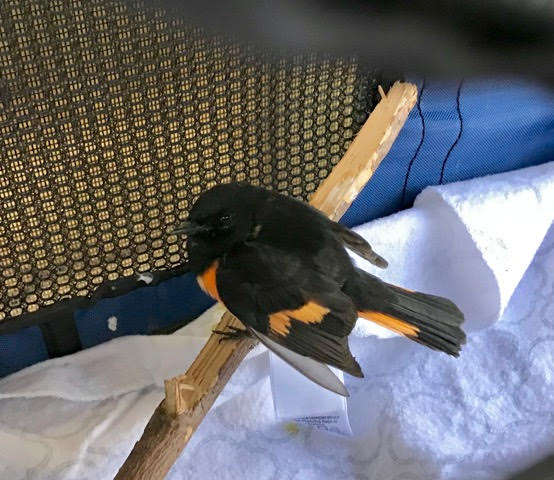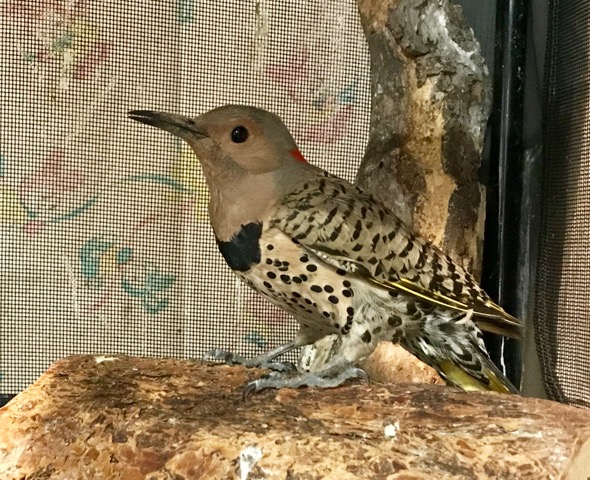Make an Impact: How to Prevent Bird-Window Collisions
- WildCare WNY

- Jul 13, 2019
- 4 min read
Updated: Dec 13, 2020
By Amanda Gabryszak & Karen Slote
Window collisions are one of the leading causes of death in birds worldwide. There’s a lot we can do to help. That said, it’s good to understand the scope of the problem.
According to a 2014 study, between 365 million and 988 million birds are killed by flying into buildings and windows each year. Researchers noted that about 44% of these fatalities occurred at regular houses, with a few sensitive species disproportionately vulnerable to collision in general, such as the Ruby-throated hummingbird, Canada Warbler and Wood Thrush (Loss et al, 2014).
Many birds that hit windows are never found. They are hidden in vegetation or scavenged by predators. And we are just not looking closely for these casualties. Some lucky birds that have been stunned by a window strike impact or injured and unable to fly are brought to rehabilitators for care by concerned members of the public. WildCare admitted four window strike cases recently: a female purple finch, a male golden-crowned kinglet, a male American redstart, and a female Northern flicker.
From left to right:
1) This female purple finch collided with a house window and fractured her shoulder. She was released after two weeks of cage rest and one week of exercise.
2) This male Golden crowned kinglet was found on a sidewalk, stunned and unable to fly; he had head trauma and internal injuries. He was released after several days’ rest.
3) This male American redstart was unable to fly and had drooping wings. He tried to eat, but was unable to swallow. Upon necropsy, it was found he had a bruised and broken jaw and throat.
4) Lastly, this female Northern flicker was found quiet with a lack of fear. She was able to fly, and was back to normal after a couple days of rest. She was released.
Sometimes when birds are found injured or deceased, a window strike is not suspected. Three golden-crowned kinglets all found dead in the same area were thought to be poisoned. Necropsy showed that all three had evidence of trauma consisting of a skull fracture, a wing fracture, and a neck and spinal injury. Impact injuries are common during fall and spring migration as birds travel in large flocks during the night.
The collisions are not the birds’ fault. Birds may see through glass windows, spotting vegetation on the other side of the house! They perceive this as ‘all clear’ and hit the window at a disproportionately high speed. Conversely, birds that fly by night may be coerced, distracted, or confused by lights within houses.
The way that we build houses, apartments, and other buildings has changed across the centuries. Windows are bigger and clearer now; we have brighter lights; the construction process is different. Bird mortality rates increase with buildings that are covered by a greater percentage of glass - or rather, that have more windows (Loss et al). With increasing sprawl and the changing shape of urban structures and more glass included in architecture to begin with, birds simply have more opportunities to fly into windows in the first place. Luckily, there are ways to help.
Applying tempera paint in patterns, hanging shades or netting, or specially-designed tape can help significantly reduce collisions. Even placing tape and decals on glass windows can be effective if stickers are placed closely together.
Additionally, keeping the conversation going - through conversation or through formal education - can help keep people informed. Students in Poland, Uzbekistan, Armenia, and Latvia recently generated bird-collision-solutions in response to a prompt from Spring Alive: “How can we make our windows bird safe?” Students designed documentaries, decals, and pinpointed high-risk areas at their school to try and improve to mitigate risk.
Closer to home, the Fatal Light Awareness Program - or “FLAP” - helps estimate the number of window collisions in North American and worldwide. Anybody can report a bird collision - all you need to do is register. The organization can then assess the collision sites and offer suggestions based on the information you provide. Additionally, the site has a live tracker that estimates the number of birds that have collided with windows per the amount of time you spend on the website. After about 20 minutes of investigating the organization, the ticker suggested over 40,000 birds had died in window collisions.
FLAP also provides a training manual and instructions on how to help start a bird-building initiative program. Beyond Toronto, organizations exist in Boston, Massachusetts, New York City, Columbus, Ohio, and Washington DC. Many of these are hosted through the local Audubon societies. A full list of initiatives can be found here: https://www.audubon.org/conservation/existing-lights-out-programs; and here: https://www.flap.org/start-a-program.php
Education is fundamentally important to helping each other understand the scope of the problem; after all, we can’t help if we don’t know that something is happening. Raising awareness can make a world of difference, especially when there is so much we can do to help prevent bird strikes. Beyond this, urban planners, architects, and landscape designers should take bird strike statistics into consideration when designing new or restoring old buildings.
Decals, stickers, and other products are available for purchase in the U.S. as well. Check out the link below from hte American Bird Conservancy to learn more. If you happen to teach or if you’re curious about coming up with a project on your own to help mitigate bird strikes, there are lesson plans available to help teach students about bird strikes and how we can prevent them. Helping birds is simple, accessible and affordable; all we need to do is raise awareness and reach out to make a difference.
https://abcbirds.org/get-involved/bird-smart-glass/












Comments